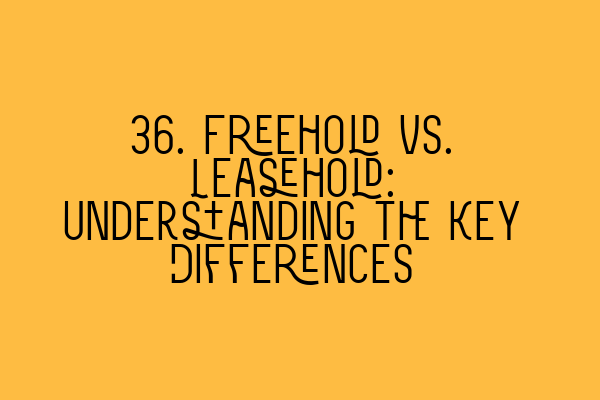Freehold vs. Leasehold: Understanding the Key Differences
When it comes to property ownership in the UK, there are two main types: freehold and leasehold. Each has its own unique characteristics and legal implications, so it’s important to understand the key differences between the two before making any decisions related to property transactions. In this article, we will dive into the details of freehold and leasehold ownership, highlighting their distinguishing features and implications.
Freehold Ownership
Freehold ownership is commonly referred to as “owning the land” or “owning the property outright.” When you own a property on freehold, you have full ownership rights over both the land and any buildings or structures on it. This means that you have complete control over the property and do not have to answer to any landlord or lease agreement terms.
Being a freeholder gives you the freedom to make decisions about the property, such as making alterations, extending or modifying the property, or selling it without needing permission from anyone else. Essentially, you have full control and can use the property as you see fit, within the boundaries of local laws and regulations.
One significant advantage of freehold ownership is that it is typically a long-term investment. Since you own the property outright, you can pass it on to future generations, providing a sense of security and stability.
However, it’s important to note that owning a freehold also entails additional responsibilities and costs. As a freeholder, you are solely responsible for maintaining and repairing the property and any associated land. This includes, but is not limited to, repairs to the roof, exterior walls, foundations, and any communal areas if applicable.
It’s crucial to keep in mind that leasehold ownership is the alternative to freehold and comes with its own specific characteristics and implications.
Leasehold Ownership
Leasehold ownership refers to a situation where a person owns the lease or “interest” in a property for a specified period of time, while the freeholder retains ownership of the land. In a leasehold arrangement, the leaseholder has the right to occupy and use the property but is subject to certain conditions outlined in the lease agreement.
A leasehold agreement is a legal contract that outlines the terms and conditions of the lease, including the length of the lease (typically between 99 and 999 years) and any associated ground rent payable to the freeholder. The lease also details certain obligations that the leaseholder must adhere to, such as obtaining permission for alterations or paying service charges for the maintenance and upkeep of communal areas.
While leasehold ownership provides the opportunity to occupy a property without the substantial upfront cost of purchasing the freehold, there are inherent limitations and potential costs to consider. These include:
- Service Charges: Leaseholders are typically required to pay annual service charges to cover the costs of maintaining and managing the communal areas or shared amenities associated with the property.
- Ground Rent: Leaseholders may also be required to pay ground rent to the freeholder, which is an annual fee for the use of the land on which the property stands.
- Lease Extension: As the lease term nears its expiration, the value of the lease may decrease, making it necessary to extend the lease. Leaseholders have the right to extend their lease, but this process can involve complex negotiations and potentially significant costs.
It’s important to thoroughly review the terms of the lease agreement before committing to a leasehold property to ensure that the conditions and associated costs align with your long-term goals and financial capabilities.
Choosing Between Freehold and Leasehold
When deciding between freehold and leasehold ownership, there is no one-size-fits-all answer. The choice depends on your circumstances, preferences, and long-term objectives.
Freehold ownership provides a greater degree of control and ownership rights but also carries more responsibilities for property maintenance and repair. Leasehold ownership offers a more affordable entry into property ownership, particularly for apartments and flats, but introduces ongoing costs and potential limitations.
Before making a decision, it’s advisable to seek professional legal advice to fully understand the implications of freehold and leasehold ownership in your specific situation. A solicitor specializing in property law can help you navigate the complexities and guide you towards the best choice for your needs.
In conclusion, understanding the key differences between freehold and leasehold ownership is crucial when engaging in property transactions in the UK. While freehold ownership provides complete control and ownership rights, leasehold ownership offers a more affordable option with certain limitations and ongoing costs. By making an informed decision based on your specific circumstances and objectives, you can ensure that your property ownership aligns with your needs and preferences.
If you found this article helpful, you may also be interested in the following related articles:
